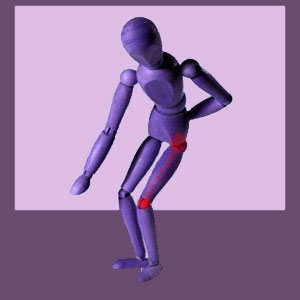
Piriformis knee pain might result from compression of the sciatic nerve, leading to symptoms in the lower appendages. Knee pain might also be a collateral consequence of injury to the piriformis muscle that prevents normal gait and ambulation. Doctors now know that the piriformis muscle is very important in our lower body physical functionality and have determined several mechanisms through which the piriformis muscle might create knee and other leg pain syndromes.
Knee pain is a very common symptomatic complaint, especially among athletes and aging people. The knee is a complicated joint that can be injured and stressed through many possible ways. However, sometimes pain in and around the knee is not directly sourced locally, but instead is created higher up in the muscular anatomy by neurological compression committed by the piriformis tissue.
This essay explores knee pain conditions that are directly and indirectly related to piriformis pathology. We will examine both piriformis syndrome and piriformis injury as potential causes of these painful complaints.
Piriformis Knee Pain from Injury
Injury to the piriformis muscle might affect the ability to stand and walk properly. Patients who have suffered trauma to the piriformis often tend to bear weight on the opposing leg and have difficulty transferring weight from one leg to the other when ambulating. Both of these occurrences can cause pain in the knee on the same side as the damaged piriformis and might cause pain in the other leg, as well, or instead of.
The knee often bears the brunt of stress when the hip joint is functionally affected by an injured piriformis muscle. Results of long-term problems affecting the knee can include iliotibial band syndrome, meniscus tears, general arthritic accumulation and other types of soft tissue injuries.
Knee Pain from Sciatic Nerve Compression
When the piriformis muscle constricts the sciatica nerve (diagnosed as piriformis syndrome), the knee can also suffer pain due to innervation concerns. Most pseudo-sciatica expressions caused by piriformis-enacted compression of the sciatic nerve create shooting pain and paresthesia down the posterior upper leg and/or far lateral (outer side) of the upper leg. However, being that sciatica is a highly variable syndrome, patients might suffer a range of diversified symptoms, including foot pain, ankle pain or knee pain, as well as, or instead of traditional upper rear and side muscular symptomology.
The knee is innervated by the sciatic nerve, so compression of this largest of all anatomical nerves can create pain, tingling, weakness, numbness and eventual dysfunction of motor and sensory abilities in the knee region and throughout the lower appendages.
Unrelated Piriformis Knee Pain
Knee pain might exist without relation to piriformis syndrome or injury. Many patients are misdiagnosed with piriformis pain, while all along, they are actually suffering from true spinally-motivated sciatica, sacroiliac joint-related compression of the sciatic nerve or localized neurological dysfunction near the knee. All of these problems can create identical expressions to piriformis knee pain conditions.
It is also possible that patients might demonstrate other structural or functional issues that might be the true source of knee pain, even if they do have a history of suffering piriformis syndrome symptoms. Some of these additional causative conditions include pronated feet, poor posture, poor ambulation technique or chronic fatigue of the leg muscles due to excessive standing or other issues.
Piriformis Pain > Piriformis Symptoms > Piriformis Knee Pain





